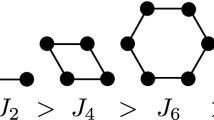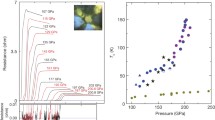Abstract
We developed a calorimeter with a vacuum container made of superconducting niobium (Nb) to study monolayers of helium adsorbed on graphite which are prototypical two-dimensional quantum matters below 1 K. Nb was chosen because of its small specific heat in the superconducting state. It is crucially important to reduce the addendum heat capacity (\(C_\mathrm{{ad}}\)) when the specific surface area of substrate is small. Here we show details of design, construction and results of \(C_\mathrm{{ad}}\) measurements of the Nb calorimeter down to 40 mK. The measured \(C_\mathrm{{ad}}\) was sufficiently small so that we can use it for heat capacity measurements on helium monolayers in a wide temperature range below 1 K. We found a relatively large excess heat capacity in \(C_\mathrm{{ad}}\), which was successfully attributed to atomic tunneling of hydrogen (H) and deuterium (D) between trap centers near oxygen or nitrogen impurities in Nb. The tunnel frequencies of H and D deduced by fitting the data to the tunneling model are consistent with the previous experiments on Nb doped with H or D.



Similar content being viewed by others
References
M. Bretz, J.G. Dash, D.C. Hickernell, E.O. McLean, O.E. Vilches, Phys. Rev. A 8, 1589 (1973). https://doi.org/10.1103/PhysRevA.8.1589
D.S. Greywall, Phys. Rev. B 41, 1842 (1990). https://doi.org/10.1103/PhysRevB.41.1842
D.S. Greywall, Phys. Rev. B 47, 309 (1993). https://doi.org/10.1103/PhysRevB.47.309
H. Godfrin, H.J. Lauter, Prog. Low Temp. Phys. 14, 213 (1995). https://doi.org/10.1016/S0079-6417(06)80018-1
H. Fukuyama, J. Phys. Soc. Jpn. 77, 111013 (2008). https://doi.org/10.1143/JPSJ.77.111013
D. Sato, D. Tsuji, S. Takayoshi, K. Obata, T. Matsui, H. Fukuyama, J. Low Temp. Phys. 158, 201 (2010). https://doi.org/10.1007/s10909-009-0013-x
D. Sato, K. Naruse, T. Matsui, H. Fukuyama, Phys. Rev. Lett. 109, 235306 (2012). https://doi.org/10.1103/PhysRevLett.109.235306
M. Ruggeri, S. Moroni, M. Boninsegni, Phys. Rev. Lett. 111, 045303 (2013). https://doi.org/10.1103/PhysRevLett.111.045303
M. Ruggeri, E. Vitali, D.E. Galli, M. Boninsegni, S. Moroni, Phys. Rev. B 93, 104102 (2016). https://doi.org/10.1103/PhysRevB.93.104102
M.C. Gordillo, J. Boronat, Phys. Rev. Lett. 116, 145301 (2016). https://doi.org/10.1103/PhysRevLett.116.145301
M.C. Gordillo, J. Boronat, Phys. Rev. B 94, 165421 (2016). https://doi.org/10.1103/PhysRevB.94.165421
B.K. Bhattacharyya, F.M. Gasparini, Phys. Rev. B 31, 2719 (1985). https://doi.org/10.1103/PhysRevB.31.2719
G.A. Csáthy, E. Kim, M.H. Chan, Phys. Rev. Lett. 88, 045301 (2002). https://doi.org/10.1103/PhysRevLett.88.045301
M. Bretz, Phys. Rev. Lett. 38, 501 (1977). https://doi.org/10.1103/PhysRevLett.38.501
M. Morishita, T. Takagi, Phys. Rev. Lett. 87, 185301 (2001). https://doi.org/10.1103/PhysRevLett.87.185301
A. Casey, H. Patel, J. Nyéki, B.P. Cowan, J. Saunders, Phys. Rev. Lett. 90, 115301 (2003). https://doi.org/10.1103/PhysRevLett.90.115301
S. Nakamura, K. Matsui, T. Matsui, H. Fukuyama, Phys. Rev. B 94, 180501 (2016). https://doi.org/10.1103/PhysRevB.94.180501
J. Nyéki, A. Phillis, A. Ho, D. Lee, P. Coleman, J. Parpia, B. Cowan, J. Saunders, Nat. Phys. 13, 455 (2017). https://doi.org/10.1038/nphys4023
S. Nakamura, K. Matsui, T. Matsui, H. Fukuyama, J. Phys. Conf. Ser. 400, 032061 (2012). https://doi.org/10.1088/1742-6596/400/3/032061
F. Pobell, Matter and Methods at Low Temperatures (Springer, New York, 2007)
A.C. Ehrlich, J. Mater. Sci. 9, 1064 (1974). https://doi.org/10.1007/BF00552819
K. Wang, R.R. Reeber, Mater. Sci. Eng. R Rep. 23, 101 (1998). https://doi.org/10.1016/S0927-796X(98)00011-4
S. Nakamura, K. Matsui, T. Matsui, H. Fukuyama, J. Low Temp. Phys. 171, 711 (2013). https://doi.org/10.1007/s10909-012-0847-5
D.S. Greywall, P.A. Busch, Phys. Rev. Lett. 67, 3535 (1991). https://doi.org/10.1103/PhysRevLett.67.3535
G.J. Sellers, A.C. Anderson, H.K. Birnbaum, Phys. Rev. B 10, 2771 (1974). https://doi.org/10.1103/PhysRevB.10.2771
D.L. Martin, Phys. Rev. 170, 650 (1968). https://doi.org/10.1103/PhysRev.170.650
B.J. Van Der Hoeven, P.H. Keesom, J.W. McClure, G. Wagoner, Phys. Rev. 152, 796 (1966). https://doi.org/10.1103/PhysRev.152.796
M.L. Siqueira, R.E. Rapp, Rev. Sci. Instrum. 62, 2499 (1991). https://doi.org/10.1063/1.1142224
H. Wipf, K. Neumaier, Phys. Rev. Lett. 52, 1308 (1984). https://doi.org/10.1103/PhysRevLett.52.1308
A.M. Stoneham, Rev. Mod. Phys. 41, 82 (1969). https://doi.org/10.1103/RevModPhys.41.82
H. Wipf, S.M. Shapiro, S.K. Satija, W. Thomlinson, Phys. Rev. Lett. 46, 947 (1981)
Acknowledgements
We are grateful to Sachiko Nakamura for helpful discussions and sharing her technical experiences on the construction of the previous Nylon calorimeter with us. The authors appreciate Megumi A. Yoshitomi for her contributions to the early stage of this work. We also thank Ryo Toda and Satoshi Murakawa for their valuable discussions and the machine shop of the School of Science, the University of Tokyo for machining the Nb calorimeter. This work was financially supported by JSPS KAKENHI Grant Number JP18H01170. J.U. was supported by Japan Society for the Promotion of Science (JSPS) through Program for Leading Graduate Schools (MERIT) and Grant-in-Aid for JSPS Fellows JP20J12304.
Author information
Authors and Affiliations
Corresponding author
Additional information
Publisher's Note
Springer Nature remains neutral with regard to jurisdictional claims in published maps and institutional affiliations.
Rights and permissions
About this article
Cite this article
Usami, J., Tokeshi, K., Matsui, T. et al. Superconducting Niobium Calorimeter for Studies of Adsorbed Helium Monolayers. J Low Temp Phys 203, 1–10 (2021). https://doi.org/10.1007/s10909-020-02558-4
Received:
Accepted:
Published:
Issue Date:
DOI: https://doi.org/10.1007/s10909-020-02558-4




